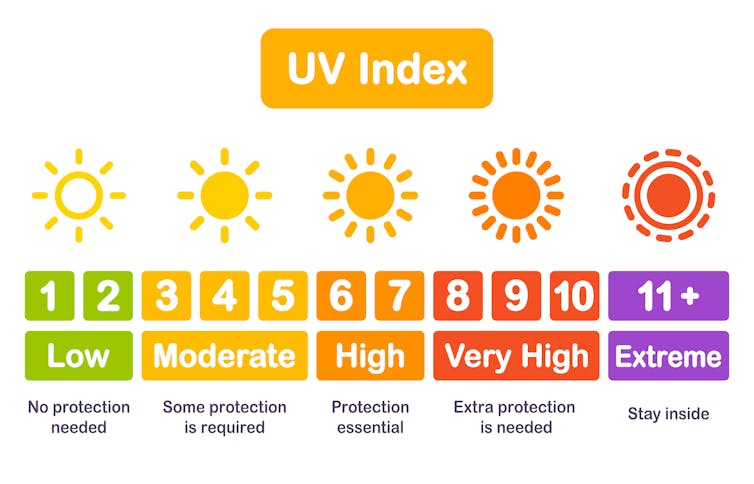Curious Kids: how does the Sun help your body make vitamin D?
- Written by Robyn Lucas, Associate Professor of Epidemiology, Australian National University
How does the Sun help your body make vitamin D? Wesley, aged 7
Thanks for this great question, Wesley.
Vitamin D is created when the chemicals in our skin react to an invisible type of light from the Sun.
In Australia, most of our vitamin D is made in our skin, but we can can also get a little bit of vitamin D from some of the food we eat like fish, eggs and mushrooms.
Read more: Curious Kids: what does the Sun's core look like?
It’s important we have vitamin D in our body as it helps to strengthen our bones and make our muscles work properly.
It’s especially important in young people when their bones are growing.
Invisible and visible light
Let’s first talk a little bit about sunlight.
Sunlight isn’t just the golden light that wakes you up in the morning or shines on your skin on a summer’s day. Sunlight actually exists in many colours, some we can see and some we can’t see.
A rainbow is an example of visible light, or sunlight you can see. Droplets of water in the sky split the light into all of its different colours.
But not all light is visible like the many colours of the rainbow.
 Rainbows are an example of visible light, but not all light is visible. Nikki Zalewski/ Shutterstock
Rainbows are an example of visible light, but not all light is visible. Nikki Zalewski/ Shutterstock
Some types of sunlight are invisible. Infrared sunlight is one of these. If you could see infrared sunlight it would sit just above the red in the rainbow.
Infrared light makes us warm as it produces heat. You might have felt it heat up your skin on a warm sunny day.
Read more: Curious Kids: does the Sun spin as well as the planets?
Another type of invisible light is ultraviolet. If you could see ultraviolet light it would be below the violet colour in the rainbow.
Ultraviolet light is also called UV light, or UV radiation.
You might be interested to know that while we can’t see infrared or ultraviolet light, most animals can. In fact, goldfish can see both infrared and ultraviolet light. Imagine what that might be like!
Which light is important in making vitamin D?
We often use something called the UV index to tell us how much UV light is outside. The UV index is sometimes reported with the weather forecast, and tells us how strong the UV radiation will be that day.
There are two types of UV light that reach us from the Sun, called UV-A and UV-B. But it’s only the UV-B light hitting our skin that causes vitamin D to be made.
 The UV index can tell you how careful you need to be about protecting yourself from the sun.
The UV index can tell you how careful you need to be about protecting yourself from the sun.
UV-B light is full of energy, a bit like a child who can’t sit still. It has more energy than UV-A and that extra energy is needed to make vitamin D.
So how exactly is it made?
When the UV-B light hits your skin, the energy in the light combines with chemicals in the very top layer of your skin.
Sometimes this results in your body making vitamin D. Other times the combination makes bad chemicals that lead to sunburn, and maybe later to skin cancers.
Read more: Curious Kids: why don't burns bleed?
When the UV-B energy is taken into a chemical, it gives the chemical more energy – scientists describe this as the chemical being “excited”.
When the heat from the infrared light is added, it gives the excited chemical even more energy – so much that the links holding the chemical together break apart and it changes into a totally different chemical.
 A chain like this is a bit like the structure of the chemicals in your skin before UV-B energy makes them excited and they change shape. Shutterstock
A chain like this is a bit like the structure of the chemicals in your skin before UV-B energy makes them excited and they change shape. Shutterstock  When the chemicals become excited the chain changes shape and becomes vitamin D. Shutterstock
When the chemicals become excited the chain changes shape and becomes vitamin D. Shutterstock
Imagine joining hands with all your friends and making a big circle, then running madly around. Some people lose their grip and their hands come apart. Suddenly it’s not a circle anymore, but a different shape.
This is what happens in the skin. The chemical that takes in the UV-B changes, because the links between atoms in the circle break, to become vitamin D.
The vitamin D is then picked up by the blood that flows through the skin.
But before it works properly in the body it has to go to the liver and then to the kidneys where it turns into the form that can help our bones and muscles.
Read more: Curious Kids: why is the Sun orange when white stars are the hottest?
But be careful not to get sunburned
So getting some sun on your skin is really important, but you don’t want to get too much or you’ll get sunburned.
In summer in Australia, the sun is so strong that you only need to be outside for a few minutes every day to keep your vitamin D up.
But it’s still good to get plenty of time outside, especially in the morning and afternoon.

If the UV index is 3 or higher it’s very important to consider sun safety. Seek shade if possible and make sure you have a hat and sunscreen on. Shutterstock
Make sure you use sun protection like a hat, clothing, and sunscreen if the UV index is 3 or higher.
In summer it’s best to stay indoors or in the shade in the middle hours of the day because the Sun is very strong. But in winter the Sun’s not as strong, so the middle of the day is a good time to get outside in the sun to get your vitamin D.
Check the Sunshine Map on HealthyBonesAustralia.org.au - recommended sun exposure for vitamin D based on location within Australia.
Hello, curious kids! Have you got a question you’d like an expert to answer? Ask an adult to send your question to curiouskids@theconversation.edu.au
Authors: Robyn Lucas, Associate Professor of Epidemiology, Australian National University
Read more https://theconversation.com/curious-kids-how-does-the-sun-help-your-body-make-vitamin-d-139670






